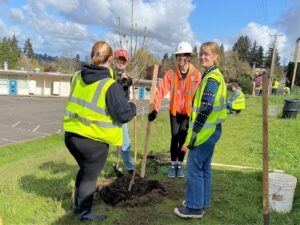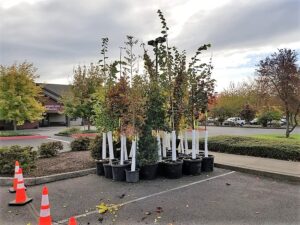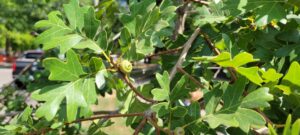Tag: street trees
Community Pruning in Eugene
Community Pruning—An Art and a Science
The Eugene Branch is in the heart of its pruning season, and has already hosted several successful community pruning events. They’ve been keeping these pruning events small and intimate so that each volunteer gets more hands-on experience. Pruning can feel like an art as much as a science, and it’s something that takes a lot of practice before you feel comfortable with it.
“We’ve had smaller pruning events in recent years because of Covid,” says Taylor Glass, Eugene-Springfield Program Manager for Friends of Trees in Eugene. “We decided to keep it small because the pruners really appreciate it.”
Each pruning event has just 15 volunteers, and they split into five groups, with one Friends of Trees staff member on each team. They prune to provide clearance over the sidewalk and the road, and they prune for good structure. In many but not all species, this includes encouraging a strong central leader.
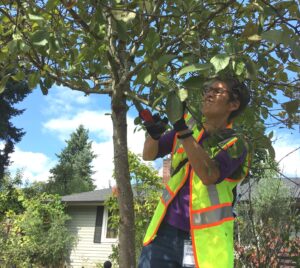
One reason that Eugene prunes in late summer, rather than in the dormant season, is that it slows the trees down. “Here, fast growth is a bigger issue than slow growth,” Erik says. Fast growing trees are tougher to manage for strength and stability, and will often have weaker wood more prone to failure, particularly in snow or ice storms, which is something you don’t want in the urban environment.
“Young tree pruning is the most cost effective thing you can do for an urban forest,” says Eugene Director Erik Burke. Pruning helps create a lasting form that won’t suffer as much damage from storms and trucks.
When you walk up to a tree that needs to be pruned, it can be tough to know where to start. Every tree is different. You have a number of goals you want to achieve, but you can only prune so much. Each pruner might make different little decisions toward the same overall goal of forming the tree.
“It’s so personal, the approach each person takes,” Erik says. “We all do it totally differently and no one way is right.”
The small pruning teams allow for a collaborative decision-making process, which grows a volunteer’s experience and confidence. And with experience and confidence, a small team can accomplish just as much as a big group.
“Volunteers can be anxious, because they want to do it right,” says Erik. “But the trees are resilient, and they’ll be fine in the long run.”
Ideally a tree gets pruned every three years for the first fifteen years of its life. We’re not always able to provide every tree with the ideal number of prunings, but thanks to volunteer efforts, we can often give trees pruning attention that they need.
Pruning a tree can be really satisfying, when you step back and look at its form take shape. And it can be especially rewarding when you see the tree grow into that form over the years. Giving volunteers hands- on involvement in the process creates a special bond to these community trees, and volunteers always want to come back to do it again.
“Teaching is a great way to learn,” Taylor says. “And with each season, you learn more.”
Planting Trees at Eugene Schools
Planting Trees at Charlemagne Elementary School
When you think of an elementary school campus, you probably think of sports fields and playgrounds. And you probably imagine trees—trees for kids to sit in the shade, or hide behind during a game of hide-and-seek, or to collect leaves from for their science classes. But a recent survey in Eugene found that the industrial areas of the city may actually have more canopy than the schools.
To help add trees at our communities’ schools, Friends of Trees did a planting at Charlemagne Elementary School in Southeast Eugene this year. The Eugene team was able to plant 32 street trees in the school’s right-of-way along Potter Street on the east side of the school’s campus. This right-of-way sees a lot of foot traffic from students. Studies show that cars drive more slowly on streets with more trees.
“We’d been hearing that students wanted trees at their school,” says Volunteer & Program Specialist Taylor Glass. “So we scouted out tree locations. The huge right-of-way had a ton of space for us to plant a whole bunch of large trees.”
The wide right-of-way allowed the team to plant trees that will grow into large shade trees, like Ponderosa Pine, Bald Cypress, Oregon White Oak, and Chinkapin Oak. The team made sure to have a mixture of both native and drought tolerant trees, so that the trees will survive and have a lasting impact on the campus. A volunteer from the neighborhood has committed to watering the trees during the first three years, while they get established.
While it’s a bit more complicated to get trees planted on the school grounds, the Eugene team could plant street trees on the right-of-way. Efforts are being made to plant on the school grounds, too.
“This has been one of our largest planting efforts at a school,” says Taylor. “We hope to be able to do more, both on the school grounds here and at other schools that could use more trees.”
Park & Ride & Shade
Partnering with TriMet to plant trees at MAX stops
We are always looking for creative places where trees can go. A MAX stop is a fantastic candidate, so when the public transportation agency TriMet came to us about a project, it made a lot of sense. Adding shade trees to MAX train stops and Park & Rides is an opportunity to improve the rider experience and address climate change at the same time.
This winter, working with TriMet with funding from the East Multnomah Soil and Water Conservation District, we planted over 100 trees at 6 different Max Stops and Park & Rides throughout Portland and Gresham.
“Trimet’s main motivation was to replace shade-producing tree canopies in our Park & Rides, as well as our swales,” says Justin Hale, Landscape Manager at TriMet. TriMet has been installing bioswales to capture and filter stormwater runoff at its MAX stops. These vegetative spaces are perfect locations for trees.
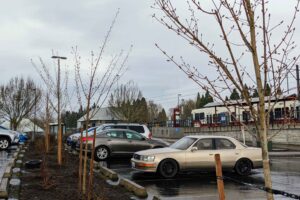
While we weren’t able to have traditional planting events at the MAX stop sites, some of the project work was completed by our crews from Portland Opportunities Industrialization Center (POIC). Much of the work was contracted to JN Landscaping, a minority-owned business in Portland.
“Transportation and tree planting are both issues that are important to our community,” Friends of Trees Deputy Director Whitney Dorer says. “This partnership was an innovative way for us to engage with transportation.”
Working with organizations like TriMet, we can find new ways to expand our tree canopy and improve heavily trafficked spaces like train and bus stops. “We are excited about replacing trees in an effort to restore our sites,” Justin says, “especially those with diminishing tree canopies.”
Trees are part of the solution to climate chaos
A letter from executive director Yashar Vasef, with an update about community tree planting in Portland
Friends,
It’s official: We need trees more than ever. Heatwaves, flooding, and all of the increasingly catastrophic effects of climate change make it clear that every day needs to be the day for climate action. Friends of Trees has been planting trees in neighborhoods and natural areas for 32 years; we’re planting street and yard trees that will shade our streets and cool our homes, prioritizing low-canopy, underserved neighborhoods, and we’re also planting native trees and shrubs to help restore sensitive natural areas.
Since 1989 we’ve planted more than 870,000 trees and native shrubs, and we’ve done this through engaging tens of thousands of community members, and while implementing and growing programming that aims to do this work inclusively and equitably.
“At a time when climate change is making heat waves more frequent and more severe, trees are stationary superheroes.” (New York Times, 7/2/2021)
It’s not enough. We are experiencing climate chaos, and trees are increasingly promoted as a major solution, which is why you may have seen Friends of Trees in the news recently. Some of that news focused on our 13 year partnership with the City of Portland Bureau of Environmental Services.
It seemed until recently that funding for our work planting and caring for street and yard trees in Portland was ending, and our concern was that with our funding ending, and without funding being awarded to anyone for community tree planting, this critical work would be suspended for an unknown amount of time. And given climate change’s growing severity, we simply cannot afford to even temporarily pause community tree planting.
It is widely acknowledged that planting trees is a key part of a comprehensive climate strategy. It is our experience at Friends of Trees that planting trees with community members is also key to fighting climate change.
Planting and caring for trees increases community members’ engagement with the environment and overall participation in civic life, including engaging around climate action. There is a ripple effect from volunteering to plant trees that also fights climate change, beyond the actual trees. We expect to have quantitative data supporting this from the research we are conducting through our community grant from the Robert Wood Johnson Foundation, look for an update this winter.
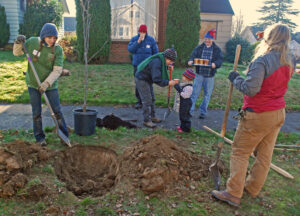
We have since learned that we will receive gap funding to partially continue our Portland tree planting and care efforts through spring 2022, and our deepest thanks go to BES, and also to Commissioner Mingus Mapps’ office, which played a critical role in this positive development. However, there are some significant changes that if implemented would drastically change community tree planting in the City of Portland. As details firm up we will continue to keep you updated.
This particular contract is so important because so much of it has funded planting street trees. Trees play an invaluable role in combating heat islands brought on by climate change, and street trees especially so. Streets and concrete sidewalks absorb and retain heat, and release it at night; street trees help fight this effect and are crucial to cooling neighborhoods.
By now most of us are aware of the inequities with Portland’s tree canopy, one result of which is more heat islands in low-canopy/low-income/under-served neighborhoods. Friends of Trees prioritizes these neighborhoods and will continue to advocate for partnerships and practices that plant trees where they are needed most.
Looking past this upcoming season, BES has said they will issue a new RFP (Request For Proposals) for this sort of work–community tree planting and tree care–sometime this fall/winter, and our understanding is that, while they acknowledge the success of our partnership, they would like to engage other, diverse community partners. And to that we say, Yes!
We fully support BES taking on a new approach to their contracts in a way that prioritizes smaller and BIPOC organizations. It is our belief that uplifting such organizations in this work will make our mission stronger and brings all of us closer to climate justice by introducing voices at the table which were previously shut out. This is why Friends of Trees, during the evolution of our 13 year partnership with BES, has entered into partnerships in this work with organizations such as APANO, Blueprint Foundation, POIC, Verde, Wisdom of the Elders, and others.

Yes, BES (and all other public and private funders) should absolutely fund more community organizations in the fight against climate change and toward climate justice, and we fully support an open RFP process. As more funders work to diversify their support of community organizations, we encourage an approach that increases the funding pie (as in, make a bigger pie as opposed to cutting smaller slices) so more partners can be included. The planet is literally on fire and NOW is the time to increase investments in climate change.
Now we really have some work to do. We are preparing for the next planting season, and we’re doing so with significantly decreased funding and options for our largest urban tree planting site, the City of Portland. In October, when we kick off our 33rd season of planting and caring for trees as a community, we’ll be coming to you to ask that you support this work like never before, since this will be a season like never before.
A global pandemic, climate change, social injustice and political strife present our community with unprecedented challenges and often devastating impacts. As we all work together to re-envision our future, a future that is green, healthy, equitable and inclusive, we must ask all our policy makers and leaders where do their values lie. And do their budgets address an urgent climate crisis unlike anything humanity has experienced? For the sake of our communities, our natural habitats, climate refugees, wildlife, and the pale blue dot we call home, together, let’s ensure they are up to the task.
All my best,

Yashar Vasef, Executive Director
Photo, top: Gambel oak tree
A lot of trees and tree stories – 16,000+ trees planted so far this season!
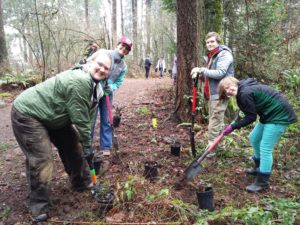
“It was an amazing day, perfect weather, awesome people and healthy trees! Couldn’t ask for a better planting day, truly.” Alex, volunteer tree planter (above photo taken at our Gresham planting event)
So far in our 2019-20 planting season we’ve planted more than 16,000 trees and native shrubs! Here are some highlights from some amazing days this season:
Neighborhood Trees Program: 820 trees planted

“It was wonderful to plant in our neighborhood! I look forward to checking up on all of our trees over the next few years.” -Neighborhood Trees volunteer planter
Green Space Program: 15,800 trees planted

“The team created a warm and welcoming environment. It was a lovely event that we truly enjoyed!” -Green Space planting volunteer


